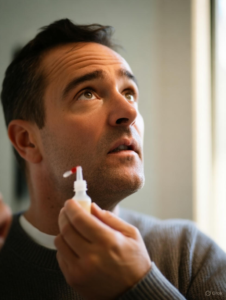Epiretinal Membrane: Causes, Symptoms, and Treatment
What Is an Epiretinal Membrane (ERM)?
An epiretinal membrane is a thin, transparent layer of tissue that forms on the surface of the retina, specifically over the macula, which is responsible for central vision.
It is sometimes referred to as a macular pucker or cellophane maculopathy.
Over time, this membrane can contract and gently pull on the retina, causing distortion and blurring of vision.
Who Is at Risk?
Epiretinal membrane is most common in people over 50 years old.
It can develop after:
- Age-related changes inside the eye
- Retinal tears or detachment
- Diabetic retinopathy or inflammation (uveitis)
- Previous eye surgery
In some cases, it may appear without any known cause.
Symptoms of Epiretinal Membrane
In the early stages, there may be no noticeable symptoms.
As the membrane thickens or contracts, patients may experience:
- Blurred or distorted vision
- Straight lines appearing wavy or bent (known as metamorphopsia)
- Difficulty reading small text
- Objects appearing smaller or larger than normal
Patients often describe it as “looking through a film or transparent curtain.”
How Is It Diagnosed?
Diagnosis is made through a retinal examination and OCT (Optical Coherence Tomography) — a high-resolution imaging technique that allows your doctor to see the retina’s layers in detail.
OCT is essential for determining the thickness, extent, and effect of the membrane on the macula.
Treatment Options
Not every case requires surgery.
If vision is only mildly affected, your doctor may recommend regular monitoring.
However, if the membrane significantly reduces visual quality or causes distortion, vitrectomy surgery may be necessary.
Vitrectomy Surgery
Vitrectomy involves removing the vitreous gel inside the eye and carefully peeling the membrane from the retinal surface using microsurgical instruments.
This delicate surgery is usually performed under local anesthesia, and most patients notice gradual improvement in vision in the weeks following surgery.
Recovery and Follow-Up
Vision improvement after surgery is gradual and may take several weeks to months.
The amount of visual recovery depends on how long the membrane has been present and the health of the underlying retina.
Postoperative care — including the use of prescribed eye drops and regular check-ups — plays an important role in the healing process.
Can Epiretinal Membrane Be Prevented?
It cannot always be prevented, but you can reduce your risk by:
- Managing diabetes and blood pressure
- Having regular eye check-ups, especially after age 50
- Protecting your eyes from trauma
- Seeking prompt care for retinal tears or bleeding
Conclusion
Epiretinal membrane is a slow-progressing eye condition that can cause distortion and blurred vision.
With modern diagnostic imaging and advanced surgical techniques, excellent visual outcomes can be achieved in most patients.
At Kaşkaloğlu Eye Hospital in İzmir, we provide the full range of diagnostic and surgical treatments for retinal conditions, using the latest technology and experienced surgical teams.
SEO Title (Meta Title):
Epiretinal Membrane – Causes, Symptoms & Treatment | Kaşkaloğlu Eye Hospital Turkey
Meta Description:
Epiretinal membrane (macular pucker) causes blurred and distorted vision. Learn about its symptoms, diagnosis, and vitrectomy treatment at Kaşkaloğlu Eye Hospital in Turkey.
Focus Keywords:
epiretinal membrane, macular pucker, retinal membrane, ERM surgery, vitrectomy, retinal diseases, eye surgery in Turkey, Kaşkaloğlu Eye Hospital, macular distortion














